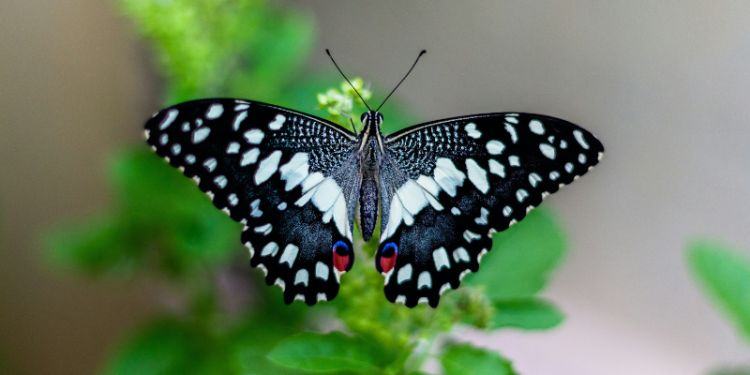Three ways climate change is pushing butterflies and moths to their limits

What drives some butterfly and moth species to decline while others thrive? Dr Elizabeth Duncan, Associate Professor in the School of Biology, explains.
In any competition, there are winners and losers. In the race to adjust to a changing climate, some butterflies seem to be doing well. But others, less so.
The brown hairstreak has been reported to be doing well around London and the UK population has been stable since the 1980s. Meanwhile, the comma butterfly boasts a 94% range expansion since the 1970s, and is now a familiar sight across England, Scotland and southern Wales.
This uplifting news is masking the plight of the UK’s other 57 breeding butterfly species. Butterfly Conservation’s 2022 report painted a grim picture. Since the 1980s, 80% of butterfly species have decreased in abundance, distribution or both.
The situation isn’t looking much better for moths, close cousins of the butterflies, with a 33% decrease in abundance of macromoths (larger moths) over the last 50 years. Eight UK butterfly species are listed as endangered and a further 16 are vulnerable.
Only 29 species are classed as least concern. So, while there are some winners, there are also many types of butterflies and moths that are clearly struggling to survive in our changing climate.
Citizen science tells us a lot about how butterfly numbers and distributions have changed since the 1970s, and sheds light on what drives some butterfly species to decline while others thrive.
1. Butterflies are picky eaters
Like half of the UK’s butterfly species, the high brown fritillary is a specialist. As a caterpillar, it depends on only one or a few plants to power its growth. The high brown fritillary relies on violets, which are mostly found in coppiced woodland and on sun-drenched slopes. Coppicing is a traditional method of woodland management, involving cutting trees down to stumps to maintain the woodland and encourage new growth.
Changes in land management, like the decline in coppicing, intensified agriculture and urbanisation, have diminished these habitats and their host plants. This endangered butterfly was once found throughout the UK, but is now restricted to only a handful of sites and conservationists are working hard to conserve this species.
2. Some don’t like it hot or cold
The wall brown, like most of the UK’s butterflies, should spend winter as a caterpillar, or in a cocoon it will emerge from after April. But mild weather in autumn and winter means that wall brown adults are emerging from their cocoons in September and October.
At this time, it’s likely too cold for the adults, there aren’t other wall browns to mate with or there aren’t enough suitable plants for their caterpillars to eat before winter. Because these adults aren’t able to reproduce successfully, fewer caterpillars survive to become butterflies the following spring – a phenomenon researchers have called a developmental trap. This is contributing to the decline of wall brown.
Warmer summers also pose a problem, with temperatures in the UK soaring last September. Unlike us, butterflies and other insects have limited ways to keep cool.
To cool down they angle their wings to not catch the direct sun and can also choose shady spots where it is often cooler. But butterflies and moths are very sensitive to the weather and extreme temperatures can cause early death in butterflies.
There are also more subtle effects of these bursts of high temperatures. In fruit flies and other insects, fertility is often reduced at temperatures lower than the lethal limit. This means that while butterflies may survive heat waves, their fertility could be reduced and this could lead to longterm population declines.
Understanding the effects of temperature on fertility in butterflies and moths is clearly a key priority and is at the forefront of ecological research.
3. Small ranges make survival tricky
The mountain ringlet is a near-threatened species that faces a different challenge. Currently only found in the Scottish Highlands and the Lake District, it lives at altitudes above 350 meters, where the air is cooler and the grass it depends on, Nardus stricta, flourishes.
Over time, these mountainous refuges will become less hospitable. Without cooler climes to retreat to, the mountain ringlet and other range-restricted butterflies may find themselves without a home.
The adonis blue (currently listed as vulnerable) is currently only seen in the south of England. As our climate warms the species may shift northwards, increasing its population. It thrives on horseshoe vetch, a plant that’s common on chalk and limestone grasslands.
But this butterfly is a real home body. It’s very sedentary and has a low tendency to disperse so it might not move north as the climate changes. Only time will tell.
What do these trends tell us?
Because butterflies and moths are sensitive to environmental fluctuations, they act as excellent bioindicators for assessing the health of ecosystems. Declines in butterfly and moth populations have serious implications.
There are noticeably fewer butterflies and moths for you and I to watch in our gardens, parks and the beautiful countryside. Butterflies and moths play a vital role in pollinating wild and crop plants including strawberries, cucumbers and apples.
Many animals, including bats, birds and other insects rely on butterflies, moths and their caterpillars as a food source. The abundance and timing of caterpillars determine when some songbirds lay their eggs, so these changing trends may alter longterm bird populations.
That said, it’s not all doom and gloom. Butterfly Conservation runs a UK-wide conservation programme, targeting 200 priority landscapes for threatened butterflies and moths. Citizen science surveys, including the big butterfly count, help scientists understand longterm trends in butterfly populations.
And you, as gardeners and nature lovers, can get involved with citizen science activities, cultivate shady butterfly-friendly habitats and help preserve urban green spaces that act as havens for these insects.
This article was orginally published in the Conversation UK online. It’s part of a series, Wild Seasons, on how the seasons are changing – and what they may eventually look like.
Reach out to Dr Elizabeth Duncan, Associate Professor of Zoology in the School of Biology, to discover more about her research into pollinators.




